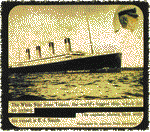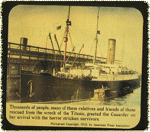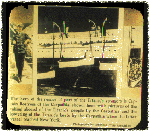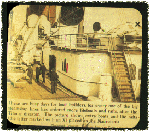Titanic: Not-So-True-Romance
James Cameron, a special-effects action director and the grand wizard of the latest Titanic movie, has been doing the media rounds, proclaiming the utter accuracy of his fabrication: five years in the creation; painstaking research for the "proper level of reality" even as far as having carpets made by the same British company that wove the originals; a slew of Titanic historians (read "buffs") consulted and paid off.

Before newsreels, movie theaters and vaudeville houses could subscribe to a service that presented news photographs on hand-colored slides. The biggest event of 1912 was recorded in these extremely rare examples. The blacked-out section on the first one most likely covers up figures that grossly underestimated the number of lives lost.
The slides are from the collection of James Card and appeared in AH Feb/March 1985.
The results are, in certain ways, highly impressive. There are near-miraculous scenes of the great engines that turned the screws and of stokers feeding coal into boilers as big as apartment houses. The wood carvings flanking the clock in the main dining salon are perfectly reproduced, as, indeed, are all the vessel's appointments. Most important, there are breathtaking views of the ship steaming magnificently toward its fatal encounter, scenes that suggest the immense scale, order, sumptuousness, and sheer physical bulk of this grandest of all liners. It's like an animated picture postcard of the period.
But after all this expensive historicism, what does the big screen tell us? That the ship hit the iceberg because lookouts were too busy watching Leonardo DiCaprio and Kate Winslet billing and cooing on the deck below.
These two kids are like time travelers—modern Yankees dropped into a court almost as remote from our time as King Arthur's. The main problem with Cameron's leviathan is that none of his characters come to period life. The two stars race around the ship calling out, "Rose! . . . Jack! . . . Rose! . . . Jack!," pause for a gob-spitting competition, and then sweet, upper-class Rose gives somebody the finger. Of course on the real ship, Jack, a third-class passenger, would never have been allowed to swan about from deck to deck, from class to class, as he does in the movie. But the wanderings of Jack and Rose in the teen-romance part of this tale allow Cameron to show off his research: There's a stilted tableau of historic personages, for the most part grossly caricatured; J. Bruce Ismay, managing director of the White Star Line, is played as a cadaverous slave driver, forcing poor Captain Smith to pile on the speed for a record crossing. In fact, there was no attempt at a speed record. And then, during the sinking, Ismay is seen sneaking into a lifeboat packed with women and children. Again—rubbish: He helped in the crisis right until the end and then only got into a boat when given permission, after it was ascertained that there were no women or children in sight. At the British inquiry (as opposed to the kangaroo court of the earlier American one) Ismay was completely exonerated.

Where were all the women and children (mostly third-class passengers) who perished? Why weren't they in the boats—many of which went off half empty? Cameron shows the poor but honest and life-embracing underclass (the first-class passengers we've met are vacuous snobs and bores) imprisoned on the lower decks, kept behind metal gates by jailer stewards. Rubbish! Nobody stopped them from proceeding to the boat decks, once the normally shut gates could be unlocked, because nobody in authority was there. There was simply no organization to the sinking—no lifeboat drill had ever been called. Titanic was unsinkable, so a disaster was unthinkable. Like poor sheep, they waited quietly for instructions that never came. There was never any panic; all was eerily calm. Such was the social order of the day.
But Cameron shows us a scene of such violence that an officer has to shoot two passengers to death and then, stricken, puts the gun to his own head. Complete fiction. Nobody was shot on the real Titanic. Speaking of officers, we see a dazed Captain Smith going down with his ship in the hoary tradition. In fact, the captain was busy issuing orders until the end; one account holds that he was last seen in the water, handing a baby into a crowded lifeboat, then swimming away into the blackness.

Because Cameron is so busy spinning out the cotton-candy romance of Jack and Rose, he hasn't time to weave in the actual—and far more interesting—passengers and their stories. For example, we are shown glimpses of Isidor Straus, the Macy's millionaire, with his wife, holding each other as they wait for death, but we have no idea who they are unless we know our history. Likewise the ship's baker: We see him quaffing from a hip flask as he sits on the stern of the almost perpendicular ship, but we never learn that it was this very tippling of hard liquor that saved his life—because he was so pickled he was able to resist an icy death for two hours before being rescued. In fact, most of the passengers died not from drowning but from exposure.
Sir Cosmo Duff Gordon, a notorious rotter, has about one line in the movie. Yet his story is thick with the stuff of good melodrama: He bribed the sailors with five-pound notes if they'd row away from the sea-girt passengers crying out for help.
All these true-life characters get short shrift in the new movie. A Night to Remember, the 1958 British picture in which a Titanic officer acted as technical advisor, tells these stories, and the result is far more satisfying.

Early reports of the Titanic's collision with the iceberg tended to be optimistic. Here is one New York newspaper's sunny assessment of the damage.
The British effort, though, perpetuates the myth that the band played "Nearer My God to Thee" even as the water lapped at their feet. Of course it makes a great scene—the bandleader dismissing his musicians and then wistfully turning around to strike up that doleful hymn, his loyal men returning to join in. Cameron borrows this passage pretty much intact from the British movie, and as a musical advisor on Titanic, I was called upon to supply the music for "Nearer My God to Thee" (there are three versions; since it was a British orchestra, I sent the English one; Cameron chose the American).
I submitted the music with the warning that the band never played the hymn. Indeed, no hymns were played on that last night—and for very good and sensible reasons. Wallace Hartley, the seasoned bandleader, knew it was his job to prevent panic, and he ordered a diet of ragtime and lulling waltzes while the evacuation was taking place. Survivors have listed the names of these rag songs: current hits like "Alexander's Ragtime Band" and "Oh You Beautiful Doll." A few months earlier, in a newspaper interview, Hartley had told the reporter that in the event of a disaster at sea he would play cheerful music. He specified that he'd never dream of playing such a doomsayer as "Nearer My God to Thee"; he had reserved that one for his funeral.
The actual last tune played by the brave little band was a beautiful waltz of the time, "Songe d'Automne"

("Dream of Autumn"). How do I know this? Because several survivors mentioned it—most notably Harold Bride, the junior radio operator and one of the last to leave the ship. In a corrective interview with The New York Times, after the tabloids had been spreading the hymn myth (started by a woman in a distant lifeboat who couldn't possibly have heard any music above the din of the dying ship), young Harold, a keen pop fan, identified the "Songe"—an easy enough thing to do because it was the rage of Britain and Europe (it later became a favorite "folk" song of a Red Army ensemble during World War II).
After playing the hit waltz, Hartley dismissed his men, and they carefully packed up their instruments and fended for themselves. This was a good half hour before the ship shot straight down into the ocean. There was no lapping-water stuff. Hartley's floating body was found several days later by a search ship; his violin case was strapped to his chest. Memorial concerts were held in England and America. The members of the Titanic band have gone on, rightly, to be remembered as being among the noblest of those on the fateful voyage. As characters in a drama, they seem to me to make more appealing material than the pair of 1990s brats with whom we have to spend so much of the voyage.
A musician himself, the British-born Ian Whitcomb came to America as part of the British rock invasion of the 1960s (he chronicles his adventures in the December 1997 American Heritage). His most recent release is Titanic: Music as Heard on the Fateful Voyage (Rhino). It includes his own White Star Orchestra's rendition of that last selection, "Songe d'Automne," and has been nominated for two Grammy awards. A recording may be found here:
